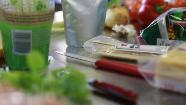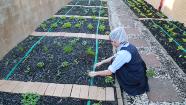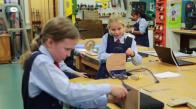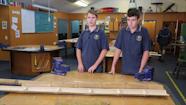Cedenco foods in Gisborne makes ingredients that are sold on the domestic market and also sent to Asia.
Food processing in a global environment – Cedenco Foods
Transcript
Carla Mcculloch: Cedenco’s a bulk ingredient manufacturer. We make paste, powders and frozen pieces, and we often pack these products into bulk packaging. 20kgs up to 1.5 tonne bins.
So you won’t see Cedenco brands on the shelf, but you will see other companies that we sell to. So Heinz, Wattie's, Nestle, Continental, Cerebos, Coca-Cola so all those types of companies – they all use our ingredients. We sell to domestic customers, so New Zealand companies, we’ll also send products to Australia and mainly Asia.
For our factory it can be a really long time from when the raw material comes into the factory and from when the material reaches the customer, so a lot of time and resources, a lot of testing, that sort of thing, to approve the product and then to get the orders ready and then off to the customer.
Pumpkin or squash is the green skin squash that we have a lot, we do a lot with. We do what we call IQFs, so Individually Quick Frozen processing. Mainly the Asian countries really like this pumpkin with the skin on, so we do a small ten ml dice with the skin on. Other customers like the skin being off the pieces, and larger chunkier what we call random cut pieces. So that’s a really, really, popular product for us and seems to be gaining momentum in the market place. Also with pumpkin we make a frozen puree and we make [an] aseptic puree as well. Then of course we do pumpkin powder. So, pumpkin is a really important vegetable for us.
An aseptic paste for us is one that's shelf stable, it gets pasteurised or heat treated at a really high temperature, really quickly, so that it maintains its colour. Then it’s packed into a multi layered foil bag which allows it to be stored at ambient temperatures for up to 2 to 3 years, so it’s shelf stable and that’s what we call the aseptic paste, so it’s commercially sterile. To have freezer and chilled space it’s really expensive for companies, so the aseptic purees and pastes are a really good option for them if they only have dry storage, so they can store it in a dry storage and that can be left for up to 2 years. So, they could buy a whole lot of product and they don’t have to have any pressures to use it straight away. Sometimes if they can use it for longer, but sometimes the colour will diminish over time.
Another product that we’ve picked up over the last couple of years is thin pumpkin slices and that goes to Japan also. The customer there deep fries it so it’s like a chip and they put it into a packet with other thin slices of onion and sweet potato or kumara. Some of our kumara. So that is in its infant stage at the moment with us and we hope that the customer will be able to grow their sales in Japan so that we can produce more for them, it’s a good product development for Cedenco.
Related videos
Real food, real fast (02:35)
Students were set a brief to develop a faster, fresher, healthier takeaway based on an analysis of a traditional recipe....
A food bag for a family dinner (03:31)
With a focus on using seasonal produce and their families as stakeholders, students produced great recipes and food bags for a family dinner....
My context and issue (04:57)
Year 13 students share about the contexts and issues they have chosen in their food technology programme.
Engaging contexts in product design (03:09)
Abby Dingle discusses materials and tools that engage students in product design.
Combining knowledge and practice (01:58)
Steve Andrew explains how understanding materials is essential for effective technological practice.
Linking hands-on experiences and understandings (03:54)
Hands-on experiences allow the students to see materials understandings in action.
Play, experiment, explore (02:55)
Steve Andrew lets the students see, feel, and play with products to develop their understandings in materials.
Finding materials to meet the specs (02:36)
Steve Andrew shares how students identify material specifications in a brief and then test materials to find those that are suitable....
School–industry relationship cuts both ways (03:36)
Steve Andrew and Terry Rillstone describe the way the relationship between St John's College and The Shop has benefits for them both....
Pushing the boundaries with materials (02:53)
Steve Andrew describes how his senior students have the confidence to select and work with unfamiliar materials.
Exploring unfamiliar materials (02:44)
Year 12 students from St John's College describe what they know about bamboo and how they are applying this knowledge to their projects....
Students and teachers talk about testing materials in year 11.
Manipulating, forming, and transforming
Students in year 10 describe manipulating, forming, and transforming materials.
Evaluating materials for an outcome
Steve Andrew and students talk about using their knowledge to test materials for their projects at year 12.
Year 10 students describe some of the attributes for the snake skates they are developing.
Senior students select their own issues
Year 12 students talk about the issues that they have selected for their projects.
















